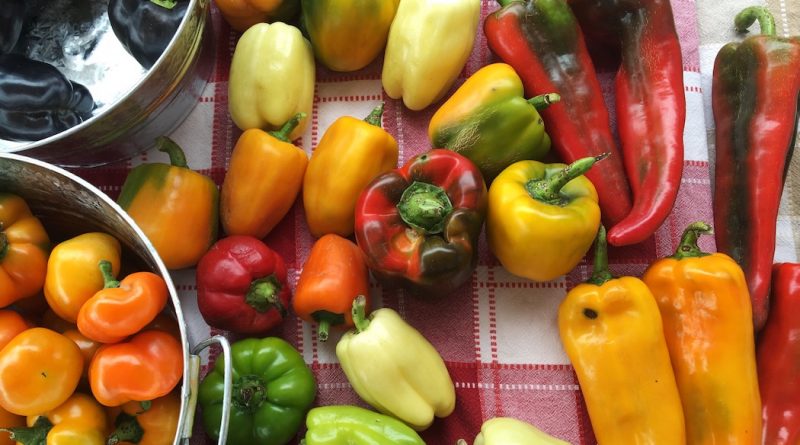Spotlight On Sustainability: “Common Home” Inspires Students To Act (Part 1 of 2)
Kaitlin Gawkins
Online Editor-in-chief
From the moment her eyes open in the morning to the last second before she drifts to sleep, environmental biology junior Marigrace Moses practices the art of intentional mindfulness. She is always considering what affect her actions will have on the world around her.
By reducing the length of her morning shower, brushing her teeth with a biodegradable bamboo toothbrush and choosing a breakfast that contains no animal products, she starts her day with the goal that each decision she makes will be sustainable. In other words, her days are centered around the convergence of meeting her personal needs while accounting for the needs of the common home she shares with the rest of creation.
And she’s encouraging us to do the same.

As an education leader for the Hanley Sustainability Institute (HSI), Marigrace heads a team of undergraduate volunteers as part of the Sustainability Activation Program (SAP). This program is centered around teaching UD students how to live more sustainably through Path Point events. Though she has loved nature and the outdoors throughout her life, she became interested in pursuing a sustainable lifestyle after observing what was going on in the world around her.
“I started hearing about how people down the street and on the other side of the world were suffering because of my careless actions. I knew I needed to learn more and then teach people about what is really going on.”
Senior environmental biology student Caroline Shepherd, Marigrace’s partner at HSI, said she always had a special care for nature. She originally gained this perspective at home from her mother. However, she ultimately made the decision to get involved with SAP because of the lack of education she witnessed in her friends coupled with their willingness to learn.

“Lots of people I talked to my freshman year said that they were open to recycling and composting, they just didn’t know how.”
When asked where they think the most recent push for sustainability education on campus came from, Marigrace and Caroline agreed HSI has been an important catalyst.
Since its conception in 2014, HSI has been a point of pride for UD. With a $12.5 million gift from their foundation, George Hanley ’77 and Amanda Hanley established the Institute with the goal of challenging the University to become a national leader for innovation in sustainability education.
It’s clear that UD has answered the call.
Over the past four years, the Institute has played a large role in increasing sustainability interest among students, faculty and staff by awarding faculty scholarship grants totaling $380,000 to teams from multiple departments, sponsoring sustainability-related conferences and creating an environment that is fruitful for open-minded discussion.

This year, HSI’s long-term work toward bringing UD’s sustainability efforts to the public eye are getting major attention. Not only did the University receive a GOLD level STARS rating from AASHE (the highest rating possible in the Sustainability Tracking, Assessment and Rating system used by colleges and universities to track their sustainability performance), but it also was recognized in SIERRA magazine’s “Top 20 Coolest Schools” for colleges that are ahead of the curve for sustainability.
SIERRA reported “UD is the first Catholic university in the nation to divest from fossil fuel companies” among other accomplishments, such as the undergraduate environmental biology program and the master’s program for renewable and clean energy.
In addition to these recent University-wide awards, environmental biology graduate and sustainability champion Meg Maloney was a finalist for AASHE’s Student Sustainability Leadership Award for her work on the creation of the SAP program.
 In her statement for the application, she highlighted the true value of the work done by the students at HSI. “Through this program, the team educates students about the importance of caring for our common home, conserving natural resources, and committing to a more sustainable lifestyle.”
In her statement for the application, she highlighted the true value of the work done by the students at HSI. “Through this program, the team educates students about the importance of caring for our common home, conserving natural resources, and committing to a more sustainable lifestyle.”
When asked what she believes to be UD’s greatest accomplishment in the realm of sustainability that she has observed, Shepherd commented she finds it impressive that most environmental biology research and sustainable initiatives on campus are led by students. “It’s so cool to see what my peers accomplish.”
One of those students who is passionate about the environment, though she may not be an environmental biology major, is junior Emily Shanahan. Shanahan is the president of the Sustainability Club at UD, in addition to being involved in the SAP program.

Shanahan hopes in the future that the HSI can partner with the Human Rights Center and potentially other interested parties that want to be more deeply involved with efforts already being made.
“I would love to see UD break down the silos in which it operates. Each school and its students are separated, as are our clubs and organizations. This stratifies our campus community and makes it more difficult to see and understand the interdisciplinary nature of sustainability,” she said.

Upon hearing from each of these key players in the many complex, active sustainability initiatives on campus, it seems the biggest inspiration is somewhat simple. That caring for our common home every day, in both big and small ways, paves the way toward building a community that is fruitful and inclusive of all creation.
Each person that was interviewed articulated a simple mission: if we truly notice the marginalized, the little pieces of the world that are not cared for, we are already on the way to connecting with the rest of creation. These little moments of intentional connection that will lead us to make decisions to better care for our common home.

